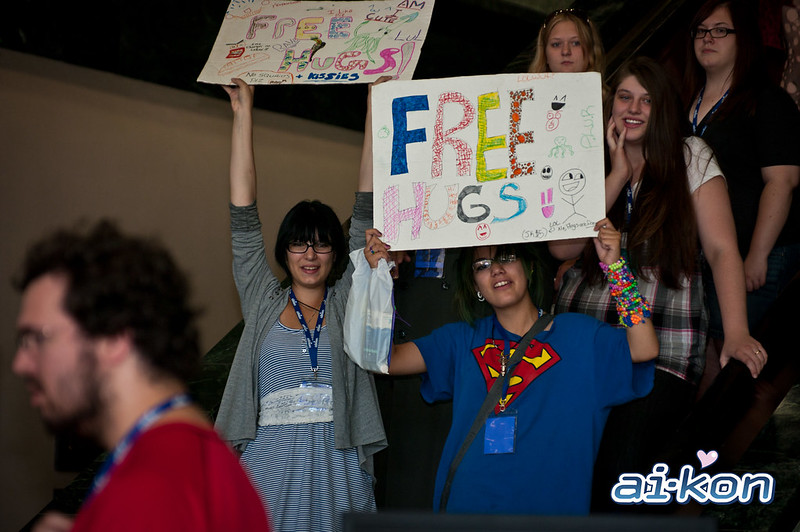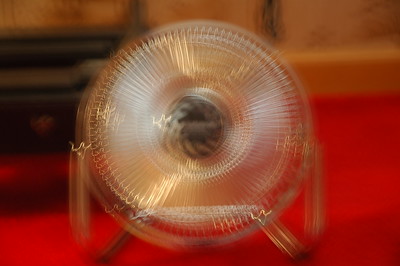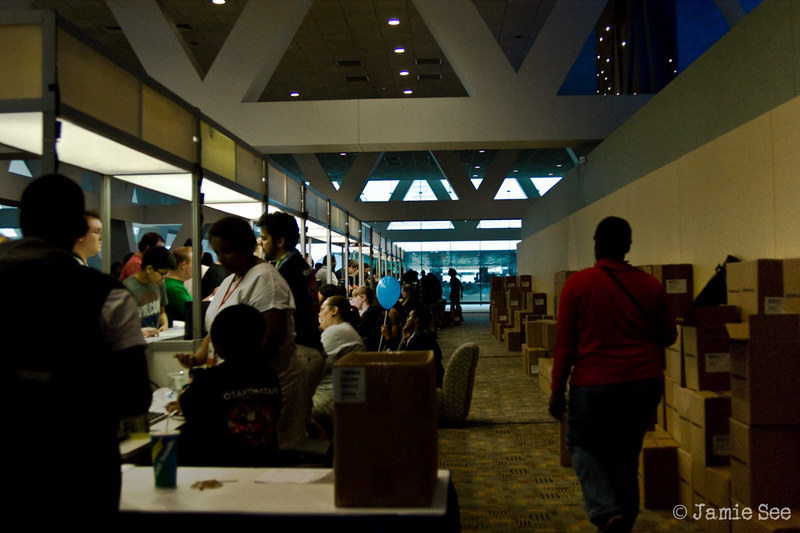This is a series of posts on convention running and my journey through conventions. For the entire series click here.
My story in fandom went from a passive consumer enjoying anime, video games and the internet fandom culture, to joining the hidden underworld of the the SMOFs (Secret Masters of Fandom) and finding out that, for some, being a creator and a builder of fandom can be even more fulfilling that just a devotion to the shows, books and things you love!
How I accepted my fandom fate
When I accepted the position of Facilities Liaison for my local anime convention, I was young in fandom. Most of the passionate interests that I had at the time and even some that I grew into from that first year have faded for me. I used to be heavy into the CW show Supernatural, but I couldn’t even tell you what the plot of the last season is. I hadn’t cultivated a pantheon of importance and I certainly hadn’t realized that there was so much around me that existed as fandom without even realizing it. For me, fandom was comic books and manga, fandom culture was the ultra nerdy subset of people who yelled “you just lost the game” in a crowded hotel lobby, to the chagrin of everyone around them.

When I started, we hadn’t even had a Brony convention yet. And even that is considered old hat now.
Fandom in 2009

To set the mood we should remember that in 2009, Youtube was still fairly unpopular. People like “Fred” were extremely popular and the content surrounding most popular youtube channels was short skits in front of a poor webcam or video game “let’s play” content. To truly put the state of fandom on the internet into perspective, 2009 was actually the year “Fred” reached 1 million subscribers on youtube.
Popular culture was now mainstream
This was a particularly interesting year in movie culture. AVATAR which would go on to hold the highest grossing film title for quite awhile, came out in 2009. But we also had things like Hannah Montana: The Movie and Twilight fever was still pretty hard. You couldn’t get away from Tween girls and their 40 something year old mothers cooing and cawing for pale, sparkly emo-boys.
These were the fandoms of that last decade, and of course Anime (the fandom I was soon-to-be part of a ConCom for) had its share of now dated hits as well. Fairy Tale would receive it’s Anime Dub in 2009 to relative critical acclaim.
My Fandom… in the Trenches
So while *gestures to everything above* all that was going on, there was little old me sitting on the floor in houses owned by people I’d only met on the internet talking about how best to allocate thousands of dollars towards putting on a 3 day convention fairly exclusively geared towards anime and Japanese popular culture. But was I a weeboo? An otaku? Were any of the fellow who sat, immersed in their behemoth laptops making charts and figuring budgets? Clearly we all had a passion for the things that had brought us to the convention in the first place – munching on pocky and reciting favorite lines from classic dubs or showing off strange hodgepodges of lesser known content direct from Japan. But were we super fans? Did we spend every waking moment, or every possible breath in our lives obsessing over anime, figurines, cosplay and Japan?

Were we super fans?
The answer is no. None of us were the sort of person you’d see on the street carrying a kawaii gudetama-chan backpack, wearing pastel color hand made lolita-attire while humming our favorite anime theme and carrying the amazing bento we’d made that morning (including adorable hotdog octopi of course!). Most of us hadn’t even seen a new anime release (in English or otherwise) and only new the classics: Dragon Ball, Sailor Moon, Cowboy Bebop, Robotech, Gundam… you get the idea. I was pretty hip to the Full Metal Alchemist beat, but even that was beginning to be a dated show. So by anyone’s standards, we were not the diehards and we certainly didn’t fit the mold of the stereotypical adult-in-their-moms-basement sweatily mashing keys to anyone who’d lend an ear. So why were we doing this? The hundreds of hours of labor and research and planning just to start the year for the convention was a huge endeavor, and none of the board of directors at this event were paid any sort of salary to take the job. Hotel rooms were covered and sometimes travel or admittance into an event for marketing were taken care of, but general speaking the time you put in far outweighed any “perks” attributed to the higher level staff. Which begs the question:
Why would anyone be a high level convention staffer?
It is interesting, isn’t it? You enjoy conventions, so you go to them and relax. Check out some panels, do some activities with your friends and experience the content available for that short amount of time. Typical conventions I’ve worked with tout anywhere from 200-800 volunteer staff members (with the outliers being places like San Diego Comic Con and Anime Expo). If you imagine a 3000+ person convention and the majority of them are partying at the rave or chilling in the gaming rooms, those poor souls watching doors and handing out badges must seem like insane, masochistic fools who were unfortunate enough to have to work their badge off like some peasant aboard the Santa Maria – joining the pilgrims for the new land but certainly not enjoying the trip as much.

And that is low level staffing, where the hours are typically 10-20 hours of the convention, and over a 3 day weekend and months of prep hours its not hard to fill those requirements and then spend the rest of the con enjoying yourself any way you like. With upper level staffing, your time suddenly becomes completely beholden to the production of the event. Those first two years as Facilities Liaison, I myself averaged 2-3 hours of sleep during the event because there was just so much to do! Why did I do it? Why put myself through sleepless nights, the stress of potential ridicule, the frustration of having a thankless, volunteer position that paid nothing? Because I had found my fandom.
Discovering your own fandom
My fandom was discovered by filling a void in the upper echelons of a convention that I cared deeply about. As I have said before, most fandoms are built over time, but this one overwhelmed me and smacked me in the face in the matter of a few short months. I interviewed for the position, met with the rest of the board of directors and suddenly everything in my life revolved around the next convention staff meeting, or the next meeting with the venue. I still went to school, went to work and had a social life, but those social gatherings became increasingly about the things I needed to do to make my fandom grow. I was conscripting friends into the process and building a social network of people who shared similar goals and had also devoted themselves to this cause. It wasn’t gradual for me as it was for most, but it also hasn’t faded as it might for some who run into fandom quickly (burning out even faster).
I realized in that first year of conventioneering that my fandom wasn’t anime, and much like my fellow con com, it wasn’t even Japanese culture as a whole. My fandom was the actual production of conventions. And as I’d learn over the years, a lot of my skills and learning choices became geared around honing that talent.
Is your fandom a little different from the traditional media fandoms? What ways do you participate in the fandom of creating or supporting fandom? Let me know in the comments below how you transcend traditional fandom!
